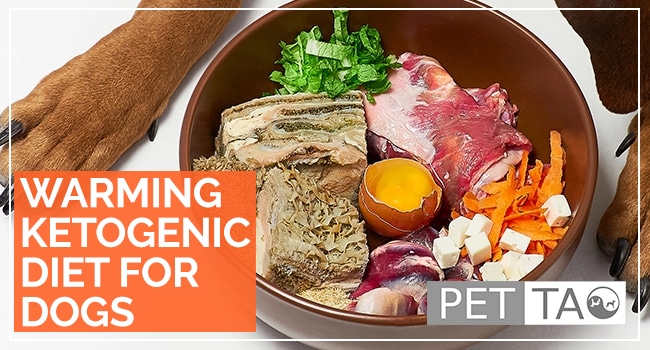Why Feed a Ketogenic Diet?
There are several reasons pet parents decide to use a ketogenic diet for dogs.
Some pet parents feel feeding a ketogenic diet is more like ancient dogs’ “primal diet”, thus keeping their dog healthier overall.
Other pet parents choose a ketogenic diet to help with specific health challenges like cancer, seizures, or diabetes.
Why Feed a Warming Diet?
We feel feeding dogs an energetically appropriate diet is best for pets, even when you choose to feed in ketogenic ratios.
Below is the recipe for a warming ketogenic diet for dogs.
A warming diet benefits dogs who:
- Move slowly
- Feel cold to the touch
- Eat sporadically
- Prefer warm surfaces
- Lack stamina
- Live in a cool climate
How to Make Warming Ketogenic Dog Food
You probably won’t be able to find commercially packaged warming ketogenic dog food.
However, you can easily make it at home in a slow cooker!
Just keep in mind, a ketogenic diet contains:
- 47%-57% Fat
- 28% -38% Protein – mostly from meat
- A maximum of 15% Carbohydrates
Then, use the list of foods below to create endless delicious recipe combinations!
Simply mix up the below ingredients using your dog’s favorite foods from the lists below.
Of course, you need to make sure the recipe fits the protein, fat, and carbohydrate ratios listed above.
We recommend using an online food log to easily track the exact protein, carbohydrate, and fat ratios of the new recipes you come up with. You can find online food logs on websites like Fitbit and Livestrong.
The ingredients listed below are all warming or neutral. It’s best to stick to all warming food items, but you may add one neutral item per batch for convenience.
We recommend using coconut oil as the fat choice, as coconut oil naturally contains 45% – 65% MCTs. MCTs are also beneficial in preventing seizures.
You can further increase your dog’s CoCurcumin intake by purchasing a canine MCT supplement and following the label instructions.
Meats/Protein Source
- Chicken
- Venison
- Shrimp, lobster
- Ham
- Sunflower seeds
- Pork, pork liver & kidney (neutral)
- Beef, beef liver (neutral)
- Fish, salmon, sardines, tuna, catfish, carp, mackerel (neutral)
- Goose (neutral)
- Pigeon (neutral)
- Chicken eggs (neutral)
- Wild rabbit (neutral)
- Quail (neutral)
Vegetables
- Pepper
- Pumpkin
- Sweet Pepper
- String beans (neutral)
- Beets (neutral)
- Cabbage (neutral)
- Carrots (neutral)
- Asparagus (neutral)
Fats
- Olive oil
- Flaxseed oil
- Peanut oil (neutral)
- Black sesame oil (neutral)
Sample Energetically Warming Ketogenic Dog Food Recipe
To make the recipe at home, you will need:
- 5 pounds of meat (see “protein” list above)
- 1.5 pounds of vegetables (see “vegetable” list above)
- 1 egg
- 4 tablespoons of olive oil
Directions:
First, debone and chop meat and vegetables.
Next, place all ingredients in crockpot layering:
- Slow cooking root vegetables on the bottom
- Meat in the middle
- Fast cooking items on top
Then, top with 1 cup of water.
Afterward, cook on low for 4 hours.
In addition, add the following to your pet’s diet:
- One canine multivitamin per day.
- Calcium supplement 22mg/lb of body weight per day. Some other good choices for calcium are eggshell powder or bone meal. If using bone meal, please note the calcium content and calculate 22mg/lb of body weight from the calcium content, not the overall bone meal content.
Feeding Schedule:
- Feed roughly 1.5 cups per 25 pounds of body weight twice daily.
- Monitor your pet’s weight. If an undesirable weight loss occurs, please contact your veterinarian immediately so that you can make an adjustment in the feeding/diet plan.
References:
- Use TCVM Food Therapy to Energetically Balance Your Pet https://pettao.com/pet-food-recipes
- Dietary intervention for canine epilepsy: Two case reports: Dietary Intervention for Canine Epilepsy: Two Case Report https://www.ncbi.nlm.nih.gov/pmc/articles/PMC6398089/
- Veterinary Practice News https://www.veterinarypracticenews.com/ketogenic-diet-zonisamide-ease-seizure
Extra Help for Your Special Needs Pet
Do you need extra help with your special needs pet? If so, we can help. Our co-founding veterinarians, Dr. Marc Smith and Dr. Casey Damron also practice TCVM (Traditional Chinese Veterinary Medicine), Alternative Medicine, Western Herbal Medicine, Acupuncture, Chiropractic, and more. Both veterinarians offer telemedicine consults and are accepting new patients.








